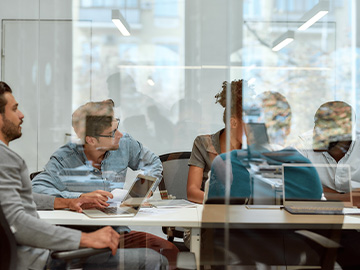In the ever-evolving landscape of our workplaces, future-proofing becomes a necessity, not a luxury. It's in this context that we bring you the latest insight piece from Inna Lim, MBA, Director of Marketing, Strategy and Execution, Corporate Services, Sodexo UK and Ireland.
Just three years ago, the thought of working from home was something I couldn't wrap my head around. Before joining Sodexo, I was working for over eight years in a company located quite near to my home. The everyday routine of heading to the office, interacting with my leaders, and sharing meals with my co-workers - who've since become friends - was a big part of what made my job enjoyable and gave me a sense of belonging. But then the pandemic hit. Everything shifted, and not just for me, but for countless colleagues we all know.
We recently had the chance to host a virtual summit all about the future of the workplace. At this event, we brought together leading figures in the industry to discuss the hurdles and opportunities that lie ahead. It gave us a unique chance to dive into new ways to improve employee experiences, rethink our workspaces, and look at how to make businesses more resilient to climate change.
Today, I want to share with you some of the interesting highlights from our virtual summit. We'll also be sending out a detailed report for executives in due time.
Rethinking the Workplace
Hybrid work has become the usual way of doing things. We know from various studies that employees like working from home because it saves them money. However, as people, we're social creatures and working remotely has put a strain on our sense of connection and overall mental health. We started to see the problems caused by not having face-to-face interactions. These include missing out on spontaneous chats and those accidental run-ins at the coffee machine where colleagues exchange thoughts and inspire each other. As a result, our team's sense of community lessened, and those light-bulb moments that spark new ideas became less common. We can't ignore the effect of less face-to-face contact on our overall well-being, and the long-term performance of the business.
To tackle these issues, companies need to step up and create spaces that put people first. We must intentionally design comfortable and inclusive spaces to encourage these interactions. By doing this, we can boost employee engagement and kickstart a wave of innovation.
As workplaces keep changing, it might become hard to adapt and create spaces that meet the varied needs of our employees. A good starting point is to move our focus from a building-first approach to a people-first approach. We need to think about the employee experience beyond just the physical boundaries of our offices and consider how we can offer support throughout the entire workday, no matter where our employees are. In the recording of our virtual summit, Doug Lowrie from the workplace strategy company Wx, chats more about what companies should bear in mind when designing the workplace of the future.
The Net Zero Office
Companies have a big role in creating a sustainable future. The seriousness of environmental problems and the loss of nature can't be overstated. Companies need to show they're really committed to sustainability. It's not just about saying it, but about taking real action.
At the same time, most leaders already understand the value to their business of reaching net zero. Our research shows that 90% of employees expect their companies to act on sustainability. And for Gen Z, it's one of the key things they look for when choosing who to work for.
Therefore, sustainability should be a part of everything we do. This is how we make truly impactful changes throughout our companies. Understanding the data we have on sustainability is also very important. Data gives us insights and helps us spot what we should focus on. It lets us effectively communicate with our employees and customers, giving them the information they need to make choices that align with their values.
Getting employees involved in sustainability initiatives is just as important, creating a shared sense of responsibility and excitement. By putting food at the heart of our sustainability efforts, offering tasty and healthy options, and giving clear information to our employees, we encourage healthier and more sustainable choices.
In our virtual summit, Claire Atkin-Morris draws up a detailed plan of what a Net-Zero office looks like, for both the front and back of the house, using her years of experience and vast knowledge in this area.
The future of work is here, and it's our job to shape it in a way that's sustainable, inclusive, and good for everyone.
Creating Employee Experiences Fit for the Future
And finally, it's all about the people. Companies today have a crucial mission to create an employee experience that supports the well-being and growth of their workforce. Without understanding the effect of physical space on individuals, it becomes difficult to plan space effectively. Likewise, making a sustainable plan involves thinking about the needs and well-being of both employees and the physical spaces they use.
Recognising how people, places, and sustainability work together is key for companies to create an environment where employees thrive, backed by the right services.
As mentioned earlier, we need to shift focus from physical measures to putting people and their experiences first. But first, we need to understand their real needs. Looking closely at detailed data lets companies make informed decisions that create a nurturing and supportive work environment. However, there's often a gap between the things that top management are interested in measuring and the things that employees lower down the ranks find important, such as issues outside of work like mental health and family matters. These things do affect the employee experience at work. So it's about understanding the bigger picture to make employees more successful. But the tricky question is, how do you find out the areas where your people are doing well or need more support? How do you link them to practical solutions? Working together with the employee experience measurement company SHAPE, Sodexo's Vital Spaces Workplace strategy initiative uses a data-led approach to provide useful insights to guide future strategies and help you make informed decisions.
The recordings from our virtual summit are now available here, giving you a front-row seat to the fascinating talks among industry leaders, including futurist and Ted-talker Anne Lise Kjaer. Whether you're a business owner, manager, or employee, the insights from this get-together are priceless. They give a peek into what the workplace and work experience might look like in the years to come, offering useful tips and guidance on how to navigate the path ahead.
The future of work is here, and it's our job to shape it in a way that's sustainable, inclusive, and good for everyone. The insights from our get-together are just the start. Let's keep the conversation going and work together to build a workplace that's ready for the future.
Inna Lim, MBA | Director of Marketing, Strategy and Execution | Sodexo Corporate Services (UK&I)
This article was originally published on Inna Lim's Linkedin profile.
You may also want to read:
- From cleanrooms to corporate offices: finding efficiencies in pharma
- Empowering Employee Experience: Unleash Your Team's Potential
- Reducing the impact of inflation on your business and your employees
Vital Spaces
Are you being brave enough to change?
.png)


